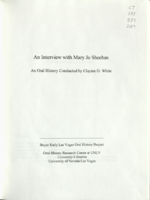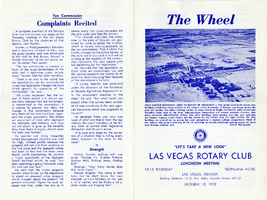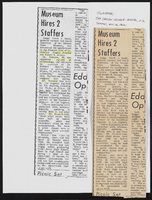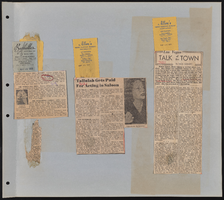Search the Special Collections and Archives Portal
Search Results
Henry C. Wieking Photograph Collection
Identifier
Abstract
The Henry C. Wieking Photograph Collection contains black-and-white photographic prints and negatives, as well as postcards of Las Vegas, Nevada between approximately 1920 and 1940. These images primarily depict Wieking and his family in front of the Las Vegas Mormon Fort and Hoover Dam (Boulder Dam). Other photographs include Six Companies and United States Bureau of Reclamation vehicles, Mount Charleston, the Colorado River, Black Canyon, and desert scenes. The remaining images depict Barstow and Death Valley, California; and a Grand Canyon bridge in Arizona.
Archival Collection

Interview with Robert Nelson, June 30, 2004
Date
Archival Collection
Description
Text

Transcript of interview with Mary Jo Sheehan by Claytee D. White, July 14, 2009
Date
Archival Collection
Description
Mary Jo Sheehan shares detailed memories of her family's early history, her father's search for work in mines in Oklahoma, Colorado, New Mexico, and Arizona, and her education through high school. She recalls with clarity the family's move to Henderson in 1945, her first job at Nellis Air Force Base, and their home in Victory Village. Mary Jo recalls bowling at the Emerald Casino, joining a sorority, and dining at the Frontier Hotel as part of her social life. She also remembers where she and her husband met in 1963. They were married at a friend's house first and later recommitted in a ceremony at St. Peter's Catholic Church. In recounting her career, Mary Jo talks of working at Nellis Air Force Base, then RFC War Assets Administration, the Colorado River Commission, and Basic Management Incorporated. Most recently she has done volunteer work for St. Rose Hospital and the Clark County Museum. Mary Jo shares many memories from her long history in Henderson, Nevada. These include events such as the PEPCON explosion in 1988 and the renovation of downtown Henderson beginning in the 90s; people like Hal Smith, Pat McCarran, and Selma Bartlett; and places such as the Swanky Club, the Emerald Casino, and the Black Mountain Golf Course. The fascinating end result is an overview of all the growth and changes in Henderson since the late forties.
Text
Carter, Leon, Sr., 1930-
Leon Carter, Sr. migrated to Las Vegas in 1942 at 12 years of age. After attending elementary school on the Westside, he enrolled for high school at Las Vegas High. Because of his schedule, he played baseball with the city team - The Cowboys. Baseball skills let him to play in Canada and Mexico. Later, when he returned to Las Vegas, his job skills in drafting and carpentry took him to the Nevada Test Site and then into the construction industry. When that did not yield enough income, He entered the gaming industry as a dealer.
Person
Las Vegas Art League
Lucille Bruner founded the Las Vegas Art League in 1950 after she moved to the city from Santa Fe, New Mexico. When the City of Las Vegas bought the Twin Lakes Lodge in what is now Lorenzi Park in Las Vegas, Nevada the Las Vegas Art League requested and obtained three buildings in which to teach and display art. The Art League became the Las Vegas Art Museum (LVAM) n 1974.
The Las Vegas Art Museum relocated to the Sahara West Library and Fine Art Museum in Las Vegas, Nevada in 1997. They remained in operation until 2009.
Corporate Body

Hernando Amaya oral history interview: transcript
Date
Archival Collection
Description
Oral history interview with Hernando Amaya conducted by Laurents Banuelos-Benitez, Marcela Rodriguez-Campo, and Barbara Tabach on October 18, 2018 and December 3, 2018 for the Latinx Voices of Southern Nevada Oral History Project. In this interview, Hernando Amaya talks about his childhood and education in Bogota, Colombia. He discusses his start in journalism as a young man and working for El Espectador, the Colombian national newspaper. He discusses his experiences reporting on the narco-terrorism occurring in Medellin, Colombia and how this eventually led to his immigration to the United States. Amaya moved to Las Vegas, Nevada in 2001 and continued his career in journalism by working for local Spanish speaking papers and websites. He relates his civic involvement in the Las Vegas area, his work as the president of the Colombian Association of Las Vegas, and various other civic engagements. As a journalist, he asserts the importance of knowing one's culture, storytelling, learning history, and being active in the community.
Text

Interview with Fred Ray Huckabee, January 7, 2005
Date
Archival Collection
Description
Text

The Wheel Las Vegas Rotary Club newsletter, October 12, 1972
Date
Archival Collection
Description
Text


